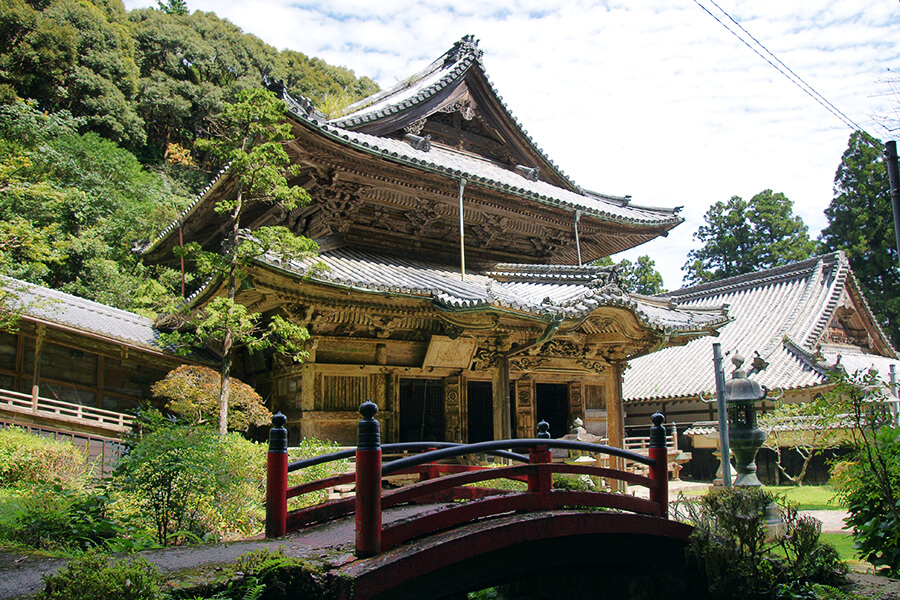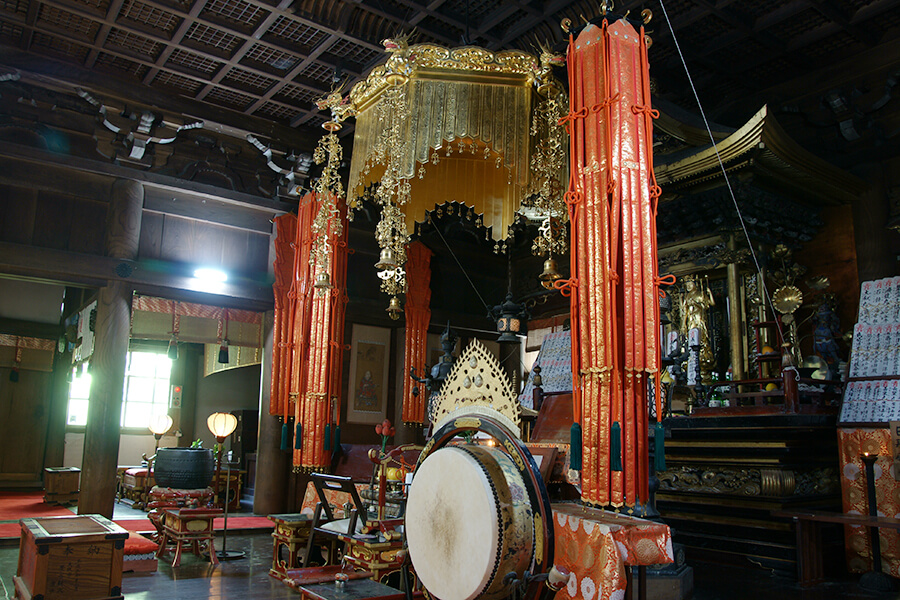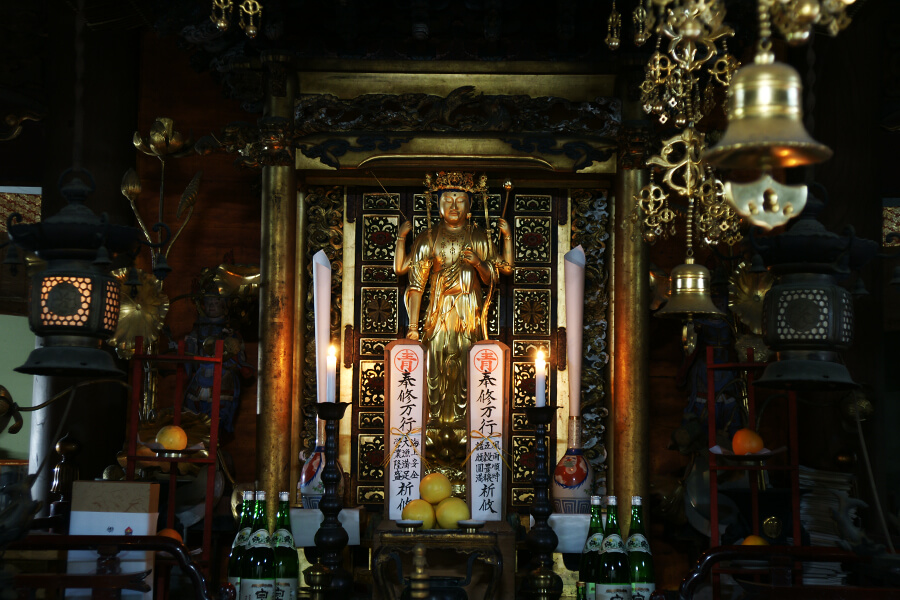Number Bangai Shōfuku-ji temple
History of the temple
The History of Shōfuku-ji temple (Sacred Mountain Aonominesan, Granting protection at the Sea)
Shōfuku-ji temple stands 336m (1102ft) above the sea level, in the middle of Ise-Shima National Park. Its terrain spreads between cities of Toba and Shima. The temple is a sacred ground and one of the important spiritual places in Tōkai area. Surrounded by beautiful nature of Aonomine mountain, Shōfuku-ji is said to be the first place in the area where Yamatohime no mikoto (the legendary daughter of Emperor Suinin (29-70), who established Ise Shrine) made a shrine devoted to Amaterasu – Shinto goddess of the Sun.
The main statue of the temple is Jūichimen Kannon (Eleven-Faced Kannon), which according to the legend appeared at the beach of Ōsatsu village, riding on the back of a whale. The Light of Wisdom (kōmyō) was emanating from her body in all directions. She flew up in the air and settled down on Aonomine mountain, where the temple lies today.
When Emperor Shōmu (701-756) was building Tōdaiji temple in Nara, many unlucky accidents happened at the construction site. He decided to go on a pilgrimage to Ise Shrine and pray for safe finish of the works. While he was passing Asama Mountain, he had a dream in which he was told: “In a south-east direction from here, there is a spiritual place called Kanka – a mountain where bodhisattva Kannon teaches the path to Enlightenment. If you build a temple and place a statue of Kannon there, all your wishes will soon be granted”. Without hesitation Emperor Shōmu ordered Gyōki (668-749), a famous monk who traveled around Japan to preach to commoners, to build a temple and call it Shōfuku-ji. Soon Tōdaiji temple was finished without any further problems. Afterwards, in the year 807, receiving the imperial order form Emperor Heijō, Kūkai (Kōbō Daishi, 774-835), the founder of Shingon sect, converted Shōfuku-ji to Shingon sect.
The main statue of eleven-faced Kannon is believed to be of divine origin and not made by a human hand. Its appearance riding the back of the whale follows the traditional image of Kannon descending on the mythical Mount Potalaka in India. The statue size is 5.5cm (2.16in) and it is hidden inside a bigger statue, which was made by Indian monk Bodhisena, who climbed the mountain in 749. The bigger statue of Kannon wears a traditional fisherman’s raincoat made from straw. Its spiritual power is enormous. According to legends this Kannon protects the sailors and during a stormy dark night, when the sailors fear for their lives, she comes to them save them. When Kannon appears she stops the crushing waves and enlightens the dark waters of the Ocean with the light emanating from her body. She is also known for answering the prayers of desperate people in hopeless situations, that is why her cult has spread all over the country.
Also there are many famous spots around the temple’s grounds. Among them there is a rock in a pond in front of the Main Hall. The rock is called a “whale rock” (kujira iwa) and it is said that the whale, on which Goddess Kannon rode, climbed the mountain, jumped into the pond and changed into this rock. It is also known by a name of “drifting island” (ukishima). Since ancient times this pond was called Ryūgū pond (Dragon Palace pond) and it was believed that the water that supplies it comes from a sacred spring. When something bad happened in the mountain area, the spring would stop flowing and the pond would instantly dry out. For some reason, also no frogs would live in this pond.
Going west from the Main Hall and climbing the mountain to the top, one will reach a place called Tensekisan (Heavenly site) which is a spiritual ground, on which it is believed that Yamatohime-no-mikoto started worshiping the Goddess of the Sun. According to the oral tradition, it is also a tomb of Yamatohime-no-mikoto. On the same spot stands also a lighthouse, which for many sailors going out to the sea is a landmark when praying to Kannon for safe return.
East from the Main Hall there is a Mount Kannon, where the statue of Kannon originally stood. One of the rocks on that mountain is believed to be a rock on which Gyōki used to meditate. The view from this mountain is also spectacular. In the West direction one can see mountains and the sea of Kii peninsula, in the East direction – past provinces of Ise, Owari, Mikawa and Tōtomi, one can even spot Mount Fuji standing above them. This magnificent view makes it a very rare place of scenic beauty.
500m (1640ft) left from the main gate of the temple stands a rock, which is called a “flame rock”. It is 15m (49ft) high and diameter of 30m (98.4ft). It is a place where in ancient times monks used to burn wooden sticks every night in a Buddhist fire ritual (goma/homa). Even now some people say that especially during dark and stormy night, one can spot a light emanating from this place.
500m (1640ft) from the temple’s grounds, along the old Matsuo path, there is a rock on which Kūkai used to perform the wooden sticks burning ritual. Since then this rock is referred to as Gomaiwa (“Rock of sticks burning ritual”).
The temple is composed of: Kondō Main Hall, Shōten Hall (Hall of Kankiten – Ganesha, a god of conjugal harmony and long life), Daishi hall (Hall of Kūkai), Benten Hall (Hall of Benzaiten, the water Goddess of Wealth and Good Fortune), Nyoirin Hall (Hall of Omnipotent Kannon), Bell Tower, Yakui gate, Daimon gate (Large front gate), Visitors hall and abbot’s quarters. Among them the Main Hall and Daimon gate are rarely seen examples of solid yet beautifully carved structures, which needed 30 years to finish. Both of them were erected between 1804 and 1818 and are architectural masterpieces which stand out among other buildings built at that time in Shima region.
In front of the Daimon gate stands a large stone lantern, which was offered to the temple by sailors working on the ships carrying sake barrels from Nishinomiya and Osaka to Edo. The stones, from which the lantern is made of, were carried through the mountain paths more than 7km all the way from Matoya. One can only imagine the enormous devotion and feeling of gratefulness these men had towards eleven-faced Goddess Kannon. Like ants, they decided to do a hard task of slowly carrying the big rocks to offer them in front of Shōfuku-ji temple.
On the left side of the Kondō Main Hall stands Ema hall (Votive tablets hall) in which countless tablets hang, offered by people who were saved by the divine power of Goddess Kannon. On each of the tablet there is a depiction of a shining Kannon who appears above a ship. The ship floats between big waves on a rough sea, while sailors get their hands together in prayer to ask her for help. To this day a lot of miracle stories are being told among the people who ask Shōfuku-ji temple Kannon for aid.

Outline
-
Honorific name
Aominesan
-
Temple's name
Shōfuku-ji
-
Sect
Kōyasan branch
-
Religious service
Jūichimen Kannon
(Eleven-Faced Kannon)





